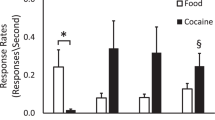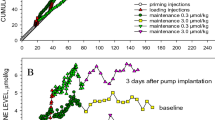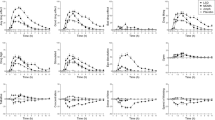Abstract
COCAINE potentiates the responses of sympathetically innervated organs to adrenaline, noradrenaline and sympathetic nerve stimulation, and several explanations have been offered for this. Cannon and Rosenblueth1 suggested that cocaine might act by preventing the destruction of injected adrenaline, or of transmitter substance released from adrenergic nerves, and Torda2 and Trendelenburg3 obtained evidence in support of this hypothesis. Macmillan4 suggested that cocaine might prevent the uptake of catecholamines into tissue stores, and block their release from these stores, but his evidence was only indirect.
This is a preview of subscription content, access via your institution
Access options
Subscribe to this journal
Receive 51 print issues and online access
$199.00 per year
only $3.90 per issue
Buy this article
- Purchase on Springer Link
- Instant access to full article PDF
Prices may be subject to local taxes which are calculated during checkout
Similar content being viewed by others
References
Cannon, W. B., and Rosenblueth, A., “Autonomic Neuro-effector Systems” (The Macmillan Co., New York, 1937).
Torda, C., J. Pharmacol. and Exp. Therap., 78, 331 (1943).
Trendelenburg, U., J. Pharmacol. and Exp. Therap., 125, 55 (1959).
Macmillan, W. H., Brit. J. Pharmacol., 14, 385 (1959).
Axelrod, J., Inscoe, J. K., Senoh, S., and Witkop, B., Biochim. Biophys. Acta, 27, 210 (1958).
Axelrod, J., Weil-Malherbe, H., and Tomchick, R., J. Pharmacol. and Exp. Therap., 127, 251 (1959).
Whitby, L. G., Weil-Malherbe, H., and Axelrod, J., Fed. Proc., 19, 295 (1960).
Whitby, L. G., Weil-Malherbe, H., and Axelrod, J. (in preparation).
Axelrod, J., and Tomchick, R., J. Biol. Chem., 233, 702 (1958).
Burn, J. H., and Rand, M. J., J. Physiol. (Lond.), 144, 314 (1958).
Carlsson, A., Rosengren, E., Bertler, A., and Nilsson, J., “Psychotropic Drugs”, 363 (Elsevier Pub. Co., Amsterdam, 1957).
Bejrablaya, D., Burn, J. H., and Walker, J. M., Brit. J. Pharmacol., 13, 461 (1958).
Author information
Authors and Affiliations
Rights and permissions
About this article
Cite this article
WHITBY, L., HERTTING, G. & AXELROD, J. Effect of Cocaine on the Disposition of Noradrenaline labelled with Tritium. Nature 187, 604–605 (1960). https://doi.org/10.1038/187604a0
Issue Date:
DOI: https://doi.org/10.1038/187604a0
This article is cited by
-
Cocaine-induced locomotor stimulation involves autophagic degradation of the dopamine transporter
Molecular Psychiatry (2021)
-
Recommendations for Substance Abuse and Pain Control in Patients with Chronic Pain
Current Pain and Headache Reports (2018)
-
Pain Management of Patients with Substance Abuse in the Ambulatory Setting
Current Pain and Headache Reports (2017)
-
Pain Control in the Presence of Drug Addiction
Current Pain and Headache Reports (2016)
Comments
By submitting a comment you agree to abide by our Terms and Community Guidelines. If you find something abusive or that does not comply with our terms or guidelines please flag it as inappropriate.



